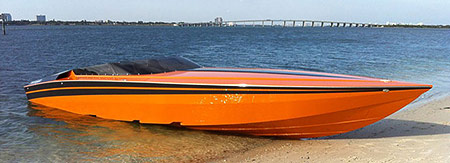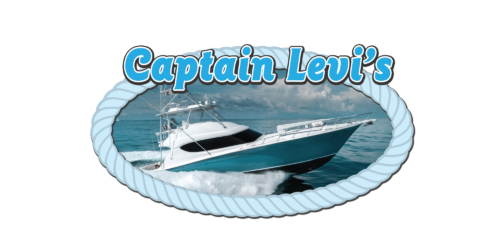
Captain Levi’s has the knowledge and experience to repair your Boat Hull Steps.
This forty-two foot, extremely high performance, Epoxy Fiberglass Reinforced power boat, built by Outerlimits Offshore Power Boats of Bristol, RI, is designed to run in excess of 160 miles an hour! That matey is a punishing activity that tests the absolute limits of the Fiberglass Boat’s Construction, Drive Train and Operator. Anything less than high quality workmanship, quality Fiberglass building materials and engineering can be fatal.
Mike Fiore, founder and President, and his father and mother, Paul and Joyce have a shared goal of building the finest custom fiberglass powerboats. Fiore’s team of savvy craftsmen understood the intricacies of impregnating carbon fiber with precise amounts of epoxy resin and fiberglass fabrics. The boat is then vacuum bagged and placed in a temperature controlled oven for a two day heating and cooling process that facilitates the maximum strength of the epoxy. It is truly state of the art Epoxy Reinforced Fiberglass boat building. This fiberglass boat has a modified quad-step deep V bottom. Captain Levi’s challenge was to repair the fiberglass epoxy quad Hull Steps that delaminated at high speeds.
The before shot clearly shows Captain Levi’s epoxy fiberglass Gel Coat boat repair challenge. As we stated above, this is hi-technologies boat construction, but as one can see 160 mile an hour speeds is a punishing activity for any boat! Captain Levi contacted our friends at the Technologies Department of ADTECH Plastic Systems. They have a complete line of over 100 precision epoxy, polyester and urethane plastic systems for Aerospace, Automotive and Marine applications, and are recognized around the globe for products designed by industry experts who are committed to uncompromising excellence. The Captain felt confident to take on the fiberglass, epoxy, polyester, gel coat boat step repair. Most fiberglass boat repair shops are hesitant of HI-performance fiberglass boat repair. Besides warranting the fiberglass repair! We have repaired many fiberglass step hull’s Donzi Marine and Fountain Power Boat’s with the same problem with their boat hull steps and hull lift chimes. But the DONZI and FOUNTAINS are built with polyester resin. Fountain Power Boats, the Washington, NC based builder of recreational fiberglass High Performance boats, has enjoyed an enviable presence on the offshore racing circuit. They have built and sold perhaps more race boats than any other manufacturer in the history of the sport since Fountain Power Boat’s pioneered the V Bottom Hull Step.
Even with the vacuum bag process there was a fiberglass fabric lamination air void that weakened the step. Back in the good old 60’s, the Captain cut his teeth building HI-Performance Deep V Fiberglass Boats. Air voids were a problem then. The Captain would take an oak wood block and hammer and tap on the boat chimes looking for air voids and repair them before the boat left his shop. Chimes and Hull Steps have tight little radiuses and can become a nightmare for the fiberglass laminating crew. Our friends at ARJAY PERFORMANCE PRODUCTS have engineered a Brushable Radius Compound that is excellent for filling tight Radius. The product is applied directly behind the polyester gelcoat. Because of this compound, there are no more nightmares for the fiberglass lamination crew. Now we were ready to grind out the air void and the delaminated area surrounding the fiberglass epoxy boat repair. This would ensure a sound bond for the fiberglass epoxy boat repair. We used a 4″ Angle Grinder with a 4″ High Speed Back-Up Plate with a 24 Grit Grinding Disk. The 24 grit disk would scarf the surface for good bonding for the new lay-up of fiberglass repair lamination.
The Captain’s choice of epoxy resin for this repair was PRO-BUILD MARINE SYSTEMS EPOXY manufactured by ADTECH PLASTIC SYSTEMS 3 to 1. It is a low viscosity resin which allows for better wet-out, resulting in lighter, stronger, and air void free layup without run-out on vertical surfaces. Hardeners are available in slow, medium and fast. The Captain chose slow for this repair. Now if we were making a fiberglass boat hull step repair on a Fountain Power Boat, a Donzi Marine Power Boat. or any Power Boat made of Polyester Resin the Captain’s choice would be Vinyl ESTER POLYESTER RESIN as it is a high-performance polyester resin, 100% vinyl-ester thixotropic laminating resin with high-heat distortion temperature. VINYL ESTER POLYESTER RESIN is stronger than any other polyester resin and cheaper than Epoxy Resin. It utilizes a polyester resin type of cross-linking molecules in the bonding process. VINYL ESTER POLYESTER RESIN is a hybrid form of polyester resin which has been toughened with Epoxy molecules within the main molecular structure. The fiberglass fabric lamination is Chopped Strand Mat Fiberglass chopped strands, about 50mm in length, and are evenly and are bounded together by a kind of special binder. It is characterized by all-direction reinforcing effects and has great bonding and good form ability while it is applied.
The 1708 Biaxial Fiberglass Fabric material is great for quick buildup and high strength fiberglass projects. This Fiberglass Fabric Material contains 17oz fiberglass woven at 45 degrees. On the backside a layer of 3/4 oz fiberglass mat is also attached. The material offers strength in various directions and is great for many projects. The thickness is .044″ and the 1708 Biaxial fabric wets out with General Purpose Polyester Resin , Vinyl Ester Resin, Isophthalic Resin, Epoxy Resin, and Polyurethane resin systems very well with another 3/4 oz. Fiberglass Mat, finished with a 10 oz. Fiberglass Cloth Fabric
Woven fiberglass cloths are very common for marine & composite construction and repair. Light weight cloths tend to provide a smooth finish and are excellent for producing a waterproofing layer over wood or other surfaces when combined with the appropriate resin. Heavier cloths provide greater strength and overall rigidity. All of our fiberglass cloths are compatible for use with our Polyester Resins and are Epoxy Resins. Fiberglass cloth has a greater tensile strength than steel wire of the some diameter.
Fairing refers to the filling and shaping of low areas so they blend with the surrounding surfaces and appear “fair” to the eye and touch. Fairing a fiberglass boat repair is more than just sanding the fiberglass repair smooth. It is the process of making the fiberglass boat repair as true to the form shape as possible. This can take some time to duplicate the shape. The Captain is not a big fan of filler putties for a fiberglass boat repair.
After fairing, the Captain’s choice of ADTECH P 77 Viyln Ester Polyester filler and fairing compound P-77 polyester filler and fairing compound offered the user a smooth workable paste with a set-fast cure to expedite those applications for repair or finish. P-77 is easier to sand than conventional fillers and can be finished to a feather edge. This material has excellent adhesive and bond strength to fiberglass, SMC, FRP, epoxy, graphite, and Kevlar® composites as well as aluminum, wood, and other substrates. P-77 can be easily applied with a squeegee, spatula, or flat tool, and once cured will accept virtually all types of coatings and decorative films.
Spray custom matched Gel Coat. Even if you do everything right to a fiberglass boat repair if the Gel Coat color does not match you fail! The fiberglass repair will stand out. Captain Levi takes great pride in our Gel Coat color matching department. Send us a sample of your Gel Coat and we will match it. Next wet sand with 500 grit sandpaper and machine buff with rubbing compound. AQUABUFF 1000 by DURATEC fiberglass materials catalog #AB1W and then machine with AQUABUFF 2000 by DURATEC catalog #AB2. We are proud to say the Captain’s fiberglass boat repair has stood the test of time and 160 + speeds.
